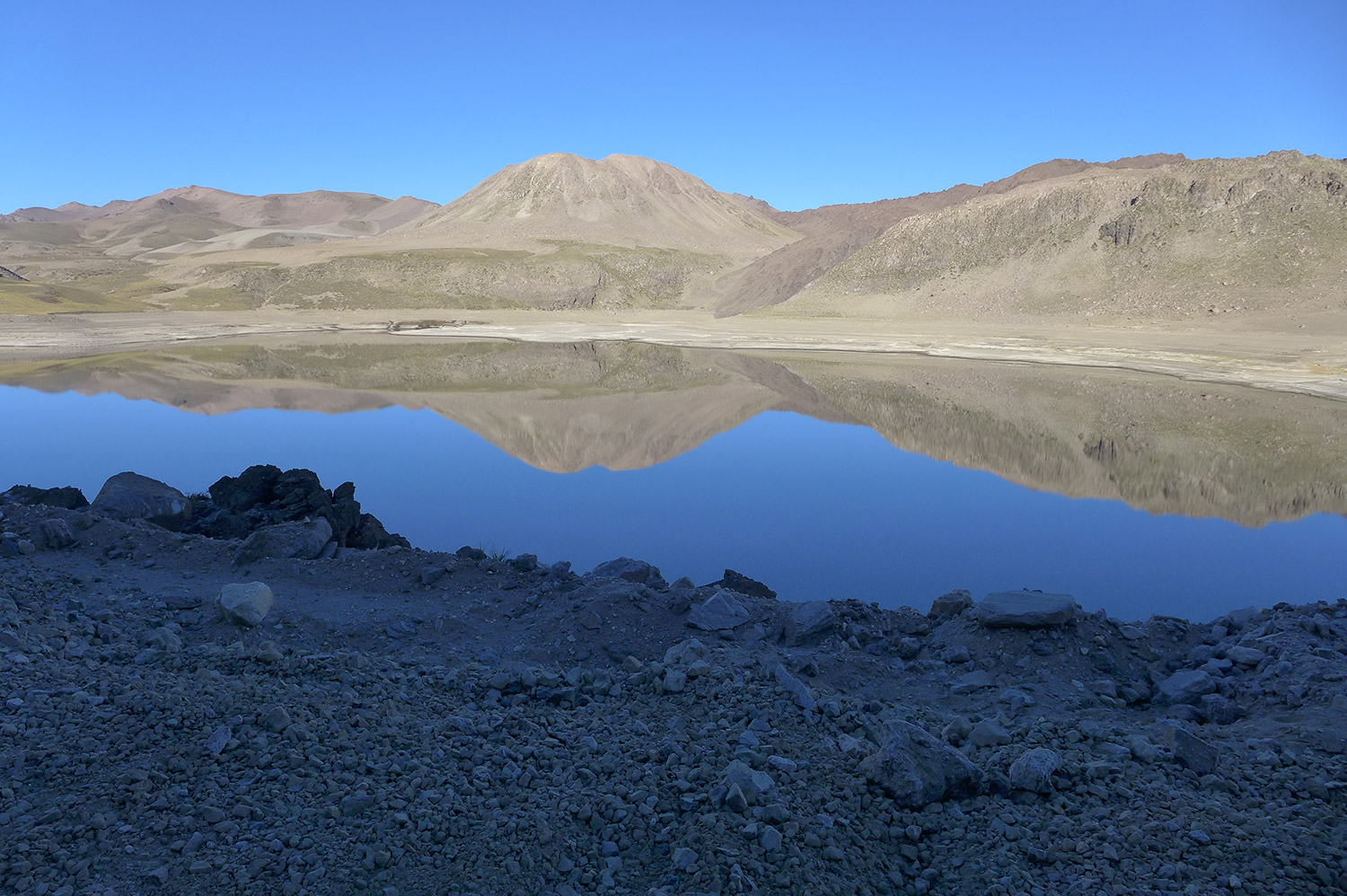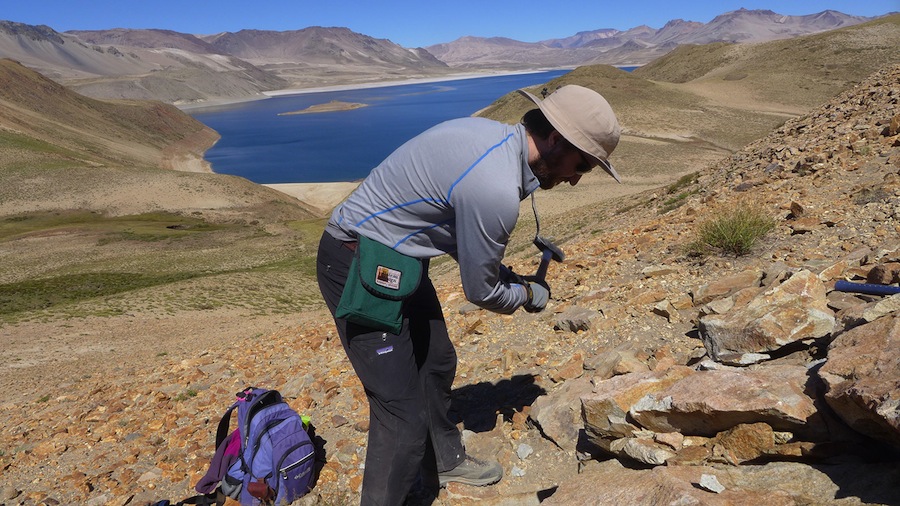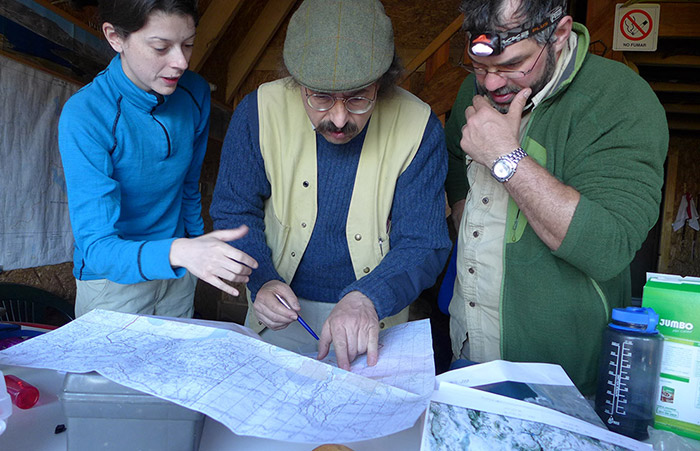
The big fault must be around here somewhere. After all, geologist Wes Hildreth put a line on the map decades ago, and he knows as much as anybody about Laguna del Maule, Chile, one of the planet's most threatening volcanic areas.
From our perch overlooking a placid lake, we can see hills, valleys and broad sloping plains. All are remnants of the many volcanic eruptions that were later altered by floods, glaciers and further eruptions.
No trees. No shrubs. Except for the ankle-high vegetation, it's a moonscape.
Here at this large volcanic field in central Chile, enormous change is normal. Thirty-six times in the past 20,000 years, the field has had a substantial eruption.
But the members of this team from the University of Wisconsin-Madison geoscience department can't identify the big crack in the ground that must have accompanied the giant eruption 950,000 years ago.
It's March 25, the first full day of UW-Madison's 2013 field season here at Laguna del Maule. Field work is an essential complement to labs and classrooms in departments like anthropology, botany, zoology, and forestry and wildlife ecology. Each year, the university sends field workers to places like Antarctica, China, Iceland, Northern Wisconsin and across the American West.

If the trip to Chile is representative, things are different in the field.
The routine is to work until daylight expires, and then retire to home base to process samples, enter data, plan for tomorrow, rustle up a quick dinner, tell tall tales, and grab some sleep.
Predictably, food gets boring, equipment breaks, and the weather turns foul. Predictably, the unknown will happen. And danger may arise, even when you are not working on a waking volcano that's capable of an eruption that could change the planet.
Ideally, field work can cement personal ties and foster emotional and intellectual maturity. No longer separated by ranks or office doors, professors and students are thrown together to work and live 24/7 in cabins, research stations or tents.
The professor-student hierarchy tends to dissolve.
But in the field, cultures and personalities can conflict, and people can get sick, or lost, or quarrelsome, or lazy. These can happen in any academic setting, except in the field you are stuck together until the flight home.
Generally, people learn to adapt.
As we collect rock samples to date the volcanic chaos under our feet, we are surrounded by the past, but it's not the ancient past, at least in geological terms. That giant ridge a couple of miles north of us was created by a lava flow that, in one geologic instant less than one million years ago, cooled into a heap of stone one-third of a mile high. That titanic eruption spewed streams of lava, clouds of ash and pumice, and torrents of fiery, chunky rock that traveled at close to NASCAR speeds.
Nearby volcanoes have vomited forth even more impressive quantities in the past, but here at Laguna del Maule, the danger is now. In January, after swarms of small earthquakes, the Chilean volcanic observatory issued a yellow alert, meaning an eruption is possible within weeks or months.
So the apparent calm is deceiving. There is danger here. Satellite measurements show extremely rapid uplift — five feet in five years — almost certainly because hot magma is swelling the underground chamber that has fueled the many volcanic vents around the beautiful lake. The ground is spreading horizontally, likely opening new channels for rising magma.
This danger helped persuade the National Science Foundation to issue a rapid grant to support our visit.

As lunch winds up on the first day in the field, Brad Singer, a professor of geoscience, puts Erin Birsic, a first-year grad student, in the driver's seat: "Where do you want to collect? What's highest priority?" Nobody has to mention that Singer is among the world's foremost experts on this bizarre terrain. But his job here is not to be expert, but to culture the burgeoning expertise in his grad students.

By mid-afternoon, Birsic has exactly one rock to show for eight hours of hiking and hammering on rocks. Then, just before quitting, she fills another white canvas sample bag. Back in Madison, Birsic will date these rocks and analyze their chemistry to track changes in the magma that caused the eruption.
That knowledge will help assess the danger at a volcanic field. We all know that, despite all the signs of renewed activity, the field could just as easily press the snooze button and return for a centuries-long sleep.
But in geology, what happened before can happen again. We are all thinking, if not talking, about that eruption almost a million years ago. That one discharged between 40 and 100 times as much rock as Mount St. Helens.
That could cool the climate, conceivably enough to cause famine. More personally, it could put us on a race-car drive down the only road out of the Andes.

The next day, we drop Birsic and Ph.D. candidate Nathan Andersen off along the road to search for more samples.
Solo work makes sense at this point, Singer says. "Erin needs to start getting self-sufficient; it's the only way she can gain the confidence she needs to be successful. The sooner I can get students out making their own decisions, the better."
One decision that team member Tor Stetson-Lee made on the trip was to accompany Singer to a nearby site that may illuminate the pool of magma currently beneath Laguna del Maule. Stetson-Lee, a former wildland firefighter, was planning to study a site in Idaho for his Ph.D. thesis, but after lugging out 50 pounds of rocks on a 10-mile hike, decided to switch his focus to Chile.
Self-direction is important in field work, as in the rest of graduate education, says John Valley, a professor of geoscience with a long record of choosing, directing and motivating graduate students. "The secret is to let them own their project. If the student has thought up the idea, they own it. They will be so much more interested and engaged, and will work harder."
Enthusiasm is a prerequisite for success in field work, says Tim Whitby, who manages field projects in Yellowstone National Park for Monica Turner, a professor of zoology. "You can come in with little knowledge, but if you are an eager, hands-on person who can see beyond the immediate repetitive work to the goals of the project, you're made for fieldwork."
Things break in the field, especially things that are mission-critical when the nearest repair shop is hours away. Take the heavy-duty drill that geoscience professor Basil Tikoff and Ph.D. candidate Helene Lemevel were using to mark the GPS instrument for their gravity measurements.
It ran perfectly last year, then died after a wire somehow broke while it idled through the Chilean winter.
As a result, Singer drove 100 miles to scour the nearest city for a soldering iron. After a two-hour, kitchen-table repair, the drill was resuscitated. Then, a few days later, it entered terminal rigor mortis.
That spirit of cooperation, which propelled Singer to volunteer a full day to repair a tool for Tikoff's project, was evident in other ways. Jobs were apportioned according to availability, not rank. Professors, if they are wise, clean dishes to start the morning. In a cabin crammed with equipment, backpacks and people, you avoid collisions with eyes on the back of your head.

Most impressive, people actually volunteered to carry rocks for each other.
Being in the field may sound romantic, but it often comes down to a camping trip with an immutable goal. And it's not for everybody, Singer says. "I took for granted that geology students would be gung-ho to get into the field. But many students like the idea of nature, but not slogging through the field."
As was obvious from their steady enthusiasm, the four students with us "are not in that category," Singer says.

Hiking across steep terrain, sleeping outside at rough camps, and lugging samples back for analysis is a great way to get an education, Birsic says. "I was not a tool-user as a kid, but I liked being outside. I didn't mind getting dirty. I learned I like camping, and want to continue doing fieldwork."
Her friends back home, she says, "find this is different; think it's interesting. Most of the time people are pretty jealous, as they should be."
Within a month of her return from Chile, Birsic had already chosen to follow her Chile-based master's with a Ph.D. focused on a cooled body of magma called a pluton located close to Laguna del Maule.
After a week in the field, Singer, who is planning a much larger effort to solve the riddle of Laguna del Maule, is happy with what he sees. "You always wonder, but the crew is getting along even better than I expected. There is a lot of chemistry between people, people want this to succeed. The students are most excited, as they should be. They are gung-ho. That's going to make or break this thing."
David J. Tenenbaum